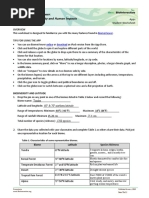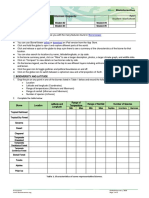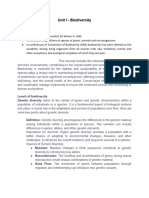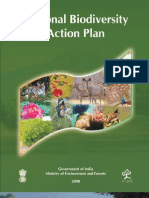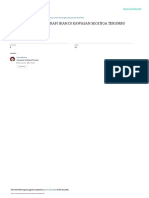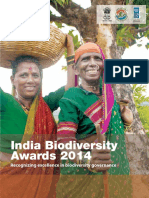BiomeViewer StudentWS App
BiomeViewer StudentWS App
Uploaded by
chereewhaleCopyright:
Available Formats
BiomeViewer StudentWS App
BiomeViewer StudentWS App
Uploaded by
chereewhaleOriginal Title
Copyright
Available Formats
Share this document
Did you find this document useful?
Is this content inappropriate?
Copyright:
Available Formats
BiomeViewer StudentWS App
BiomeViewer StudentWS App
Uploaded by
chereewhaleCopyright:
Available Formats
BiomeViewer:
Biodiversity and Human Impacts Apps
Student Worksheet
OVERVIEW
This worksheet is designed to familiarize you with the many features found in BiomeViewer.
TIPS FOR USING THE APP
You can use BiomeViewer online or download an iPad version from the App Store.
Click and hold the globe to spin it and explore different parts of the world.
Click and release a spot on the globe to drop a pin there to see a summary of the characteristics of the
biome for that location.
You can also search for locations by name, latitude/longitude, or zip code.
In the biome summary panel, click on “More” to see a longer description, photos, a larger climate graph, and
wildlife data.
Click on “Compare” to view details on two biomes side by side.
On the biomes legend, use the arrows at the top to see different layers including anthromes, temperature,
precipitation, and terrain.
Click the gear icon to toggle gridlines and political boundaries on and off.
Click on the globe icon to switch between a spherical view and a flat projection of Earth.
BIODIVERSITY AND LATITUDE
1. Drop the pin on any point in one of the biomes listed in Table 1 below and record the following:
Biome name: ____________________________
Desert
Latitude and longitude: __________________________
45.7 N, 68.7 L
Range of temperatures: Minimum __________________
-8 Maximum __________________
25
Range of rainfall: Minimum __________________
580 Maximum __________________
1100
Total number of species (richness): _________________
47
2. Share the data you collected with your classmates and complete Table 1 as others share their data. Pick just
one representative location for each biome.
Table 1. Characteristics of some representative biomes.
Biome Latitude Species Richness
Tundra 67.4 22
Boreal Forest 61.4 41
Temperate Deciduous Forest 56.5 60
Desert 42.8 36
Tropical Rain Forest 52.6 187
Alpine 34.6 23
Ecosystems Published January 2018
www.BioInteractive.org Page 1 of 3
Apps
BiomeViewer: Biodiversity and Human Impacts Student Worksheet
3. Based on the completed table, do an “I see, I think, I wonder” activity by completing Table 2.
Table 2. Questions about patterns in biomes.
I see I think I wonder
What patterns do you observe? What can you infer from the What else would you like to
patterns? explore?
According to the table, For the wet biomes I want to explore more
the biomes that has a such as rainforests, about the amount of
enough amount of light it has more amount of populations for each
and water, and soil amphibian species than species.
such as rain forest has other biomes. For
the biggest species example, the biomes
than other biomes. For such as desert, or
example, for the center forests, it has a
of the earth, we can larger species
observe that there are richness than other
lots of deserts. So we biomes.
can know that there are
more lights for the
center of the earth.
4. Change the view to a flat map and turn on the gridlines. Click on the Sahara Desert near the Tropic of
Cancer. Click “compare” and select the tropical rain forest biome in Southeast Asia at about the same
latitude. Then, answer the following questions:
a. How do rainfall and temperature patterns differ between the biomes?
Tropical rainforest is more wet, and desert is dry. According to the data, for the desert
temperature difference, its about 30 degrees difference, but on the other hand, rainforest has a
difference of 10 degrees.
b. List the species richness for each biome.
31 226
Sahara Desert: ______________ SE Asia Tropical Forest: _____________
c. Think about the difference or similarity in species richness between these two biomes. What could
account for this difference or similarity?
The similarities of species richness between two biomes are that they both have mammals, and
reptiles. But according to the top species richness for each biome part b, we can notice that
they have big difference. We can expect that becasue the tropical forest has enough amount of
light and water, and soil, which is very important sources for organsims, it has big amounts. But
on the other hand, Desert has less species. We can expect about this statement that becasue
Desert has less water then tropical forest which is very dry, but tropical forest is wet. The word
‘dry’ defines to less water. These could be the reasons why they have big differences between
the amounts of speices richness. Furthermore, there are more amphibians for rainforest biome,
by this, we can know that rainforest is very wet
Ecosystems Published January 2018
www.BioInteractive.org Page 2 of 3
Apps
BiomeViewer: Biodiversity and Human Impacts Student Worksheet
HUMAN IMPACTS ON BIODIVERSITY
5. Go back to your original biome from question 1. Make sure you are still in flat map view. Change to the
Anthrome layer and select the year 2000.
a. Select the point in your biome with the highest level of human disturbance. List the Anthromes at this
location for each of these years:
Wildlands
1700: _________________________
1800: _________________________
Wildland
Wildland
1900: _________________________
Rangelands
2000: _________________________
b. Briefly summarize how humans have impacted the environment at this location over time.
I think beacsue of deforestation that could impacted the environment .
c. At this location, record the following:
Wildland
Anthrome (year 2000): _______________________
43
Species Richness: ________________
35
# Species NOT listed as “Least Concern”: ___________
d. Now select the point in your biome with the lowest level of human disturbance. Ideally, it should be a
wilderness area, but as close as possible to the last location. Record the following:
Seminatural
Anthrome: _______________________
48
Species Richness: ________________
39
# Species NOT listed as “Least Concern”: ___________
e. Summarize the differences in species richness and IUCN status of species between the two locations.
Make a claim for how human disturbance could have impacted biodiversity in your biome. Support your
claim with evidence.
For the less human distribance area, it has more bigger least concern, and it has less least
concern for wildland. (Higher human distribance)
Ecosystems Published January 2018
www.BioInteractive.org Page 3 of 3
You might also like
- Biomeviewer: Biodiversity and Human Impacts: Tips For Using The App100% (3)Biomeviewer: Biodiversity and Human Impacts: Tips For Using The App3 pages
- Biomeviewer: Biodiversity and Human Impacts: Tips For Using The App100% (1)Biomeviewer: Biodiversity and Human Impacts: Tips For Using The App3 pages
- Biomeviewer: Biodiversity and Human Impacts: Biomeviewe RNo ratings yetBiomeviewer: Biodiversity and Human Impacts: Biomeviewe R3 pages
- Santiago Quezada Sanchez - Student WorksheetNo ratings yetSantiago Quezada Sanchez - Student Worksheet3 pages
- Student BiomeViewer - Environmental Science HomeworkNo ratings yetStudent BiomeViewer - Environmental Science Homework3 pages
- Biomeviewer: Biodiversity and Human Impacts: Tips For Using The AppNo ratings yetBiomeviewer: Biodiversity and Human Impacts: Tips For Using The App3 pages
- GR-6 - Half Yearly Revision Worksheet 2 2023-24 Answer KeyNo ratings yetGR-6 - Half Yearly Revision Worksheet 2 2023-24 Answer Key4 pages
- Test: Living Things and The Environment: Interpreting DiagramsNo ratings yetTest: Living Things and The Environment: Interpreting Diagrams4 pages
- Olivier Estime - Biome Virtual ExplorationNo ratings yetOlivier Estime - Biome Virtual Exploration4 pages
- Science6 Q2 Mod6 EcosystemTropicalRainforestsCoralsReefsandMangroveSwamps V4No ratings yetScience6 Q2 Mod6 EcosystemTropicalRainforestsCoralsReefsandMangroveSwamps V426 pages
- Buy ebook Ecology 4th Edition William D. Bowman cheap price100% (1)Buy ebook Ecology 4th Edition William D. Bowman cheap price50 pages
- IAL Geography Unit 3 Biodiversity Under Threat Topic Guide100% (2)IAL Geography Unit 3 Biodiversity Under Threat Topic Guide24 pages
- COT 1 Interaction Among Living Things and Non Living Things in Tropical Rainforest NewNo ratings yetCOT 1 Interaction Among Living Things and Non Living Things in Tropical Rainforest New9 pages
- Answer To Activity For Week Starting 03312020 To 04032020No ratings yetAnswer To Activity For Week Starting 03312020 To 040320202 pages
- Science Lesson For 8th Graders (2nd Unit)No ratings yetScience Lesson For 8th Graders (2nd Unit)3 pages
- Get Ecology 4th Edition William D. Bowman free all chaptersNo ratings yetGet Ecology 4th Edition William D. Bowman free all chapters40 pages
- Populations, Communities, Ecosystems, and BiomesNo ratings yetPopulations, Communities, Ecosystems, and Biomes92 pages
- Biodiversity: Explore the Diversity of Life on Earth with Environmental Science Activities for KidsFrom EverandBiodiversity: Explore the Diversity of Life on Earth with Environmental Science Activities for KidsNo ratings yet
- (Gossling, 1999) Ecotourism, A Means To Safeguard Biodiversity and Ecosystem FunctionsNo ratings yet(Gossling, 1999) Ecotourism, A Means To Safeguard Biodiversity and Ecosystem Functions18 pages
- Writing 2 Reason Solution of Plant Animal DeclineNo ratings yetWriting 2 Reason Solution of Plant Animal Decline3 pages
- FS11 Habitat Like That - Landscape Architecture For The San Diego ZooNo ratings yetFS11 Habitat Like That - Landscape Architecture For The San Diego Zoo3 pages
- Grade 8 Holiday Homework Hopetown Girls' School Write Your Answers in The Same Worksheet. A. Match The Column:-A: - Protected Area Animals MaintainedNo ratings yetGrade 8 Holiday Homework Hopetown Girls' School Write Your Answers in The Same Worksheet. A. Match The Column:-A: - Protected Area Animals Maintained3 pages
- Global Analysis of Streamflow Response To Forest ManagementNo ratings yetGlobal Analysis of Streamflow Response To Forest Management2 pages
- How Many National Parks in India 2024 - Google SearchNo ratings yetHow Many National Parks in India 2024 - Google Search3 pages
- Wildlife Conservation: Major Dangers To WildlifeNo ratings yetWildlife Conservation: Major Dangers To Wildlife6 pages
- IUCN - CMP Unified Classification of StressesNo ratings yetIUCN - CMP Unified Classification of Stresses2 pages
- Pemanfaatan Jasa Lingkungan Di Hutan Desa Buntoi, Kecamatan Kahayan Hilir, Kabupaten Pul...No ratings yetPemanfaatan Jasa Lingkungan Di Hutan Desa Buntoi, Kecamatan Kahayan Hilir, Kabupaten Pul...17 pages




